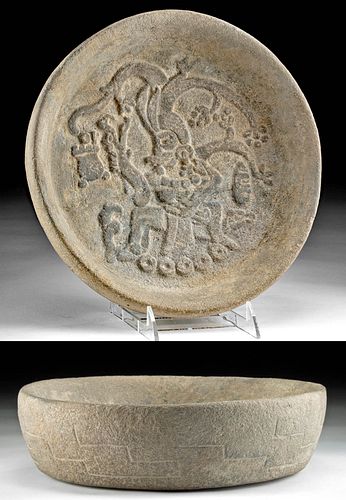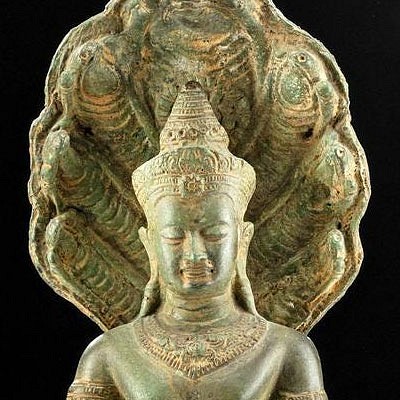Ritualistic Maya Stone Bowl w/ Lord
Lot 105
About Seller
Artemis Fine Arts
686 S Taylor Ave, Ste 106
Louisville, CO 80027
United States
Selling antiquities, ancient and ethnographic art online since 1993, Artemis Gallery specializes in Classical Antiquities (Egyptian, Greek, Roman, Near Eastern), Asian, Pre-Columbian, African / Tribal / Oceanographic art. Our extensive inventory includes pottery, stone, metal, wood, glass and textil...Read more
Categories
Estimate:
$20,000 - $30,000
Absentee vs Live bid
Two ways to bid:
- Leave a max absentee bid and the platform will bid on your behalf up to your maximum bid during the live auction.
- Bid live during the auction and your bids will be submitted real-time to the auctioneer.
Bid Increments
| Price | Bid Increment |
|---|---|
| $0 | $25 |
| $300 | $50 |
| $1,000 | $100 |
| $2,000 | $250 |
| $5,000 | $500 |
| $10,000 | $1,000 |
| $20,000 | $2,500 |
| $50,000 | $5,000 |
| $100,000 | $10,000 |
| $200,000 | $20,000 |
About Auction
By Artemis Fine Arts
Aug 10, 2021
Set Reminder
2021-08-10 12:00:00
2021-08-10 12:00:00
America/New_York
Bidsquare
Bidsquare : Museum-Deaccession | Asian & Pre-Columbian
https://www.bidsquare.com/auctions/artemis-gallery/museum-deaccession-asian-pre-columbian-7316
An interesting mix of de-accessioned Asian and Pre-Columbian Art from The Ashland University Museum in Ashland, OH, originally donated between 1994 to 1998. All lots from the Museum have been noted, as such. Artemis Fine Arts info@artemisgallery.com
An interesting mix of de-accessioned Asian and Pre-Columbian Art from The Ashland University Museum in Ashland, OH, originally donated between 1994 to 1998. All lots from the Museum have been noted, as such. Artemis Fine Arts info@artemisgallery.com
- Lot Description
Pre-Columbian, Southern Mexico to Guatemala, Maya, Preclassic to Classic Period, ca. 100 to 300 CE. A large carved stone dish with a carved relief scene in the shallow interior basin depicting a striding lord wearing an elaborate headdress of twining vegetative vines. He appears to be standing upon a serpentine zoomorph. In his left hand he holds a teardrop shaped item, perhaps a celt. The exterior of the bowl is incised with a classic stepped motif. Ornate stone bowls of this type and size are quite rare and likely had a ceremonial purpose. Serpents provide a fascinating element of Pre-Columbian iconography as they were regarded to be a beneficial source of nourishment and, at the same time, venomous and therefore quite deadly. Also important to the Maya was how snakes shed their skin annually, thus rejuvenating themselves and serving as symbols of renewal and good health. Size: 11" Diameter x 3" H (27.9 cm x 7.6 cm)
Provenance: private Hawaii, USA collection; ex-Robert Stolper collection, one of the 1950 old dealers; Acquired from Everett Rassiga, as well one of the 1950-60 dealers that acquired artifacts from East European Communist Countries Museums against foreign currency exchange; Ex Bucharest National Museum, Hungary
All items legal to buy/sell under U.S. Statute covering cultural patrimony Code 2600, CHAPTER 14, and are guaranteed to be as described or your money back.
A Certificate of Authenticity will accompany all winning bids.
PLEASE NOTE: Due to recent increases of shipments being seized by Australian & German customs (even for items with pre-UNESCO provenance), we will no longer ship most antiquities and ancient Chinese art to Australia & Germany. For categories of items that are acceptable to ship to Australia or Germany, please contact us directly or work with your local customs brokerage firm.
Display stands not described as included/custom in the item description are for photography purposes only and will not be included with the item upon shipping.
#161512Minor abrasions and surface chips. Softening of details. Nicks to rim and light mineral deposits. Old inventory numbers written on surface.Condition
- Shipping Info
-
All shipping is handled in-house for your convenience. Your invoice from Artemis Gallery will include shipping calculation instructions. If in doubt, please inquire BEFORE bidding for estimated shipping costs for individual items.
-
- Buyer's Premium



 EUR
EUR CAD
CAD AUD
AUD GBP
GBP MXN
MXN HKD
HKD CNY
CNY MYR
MYR SEK
SEK SGD
SGD CHF
CHF THB
THB
















